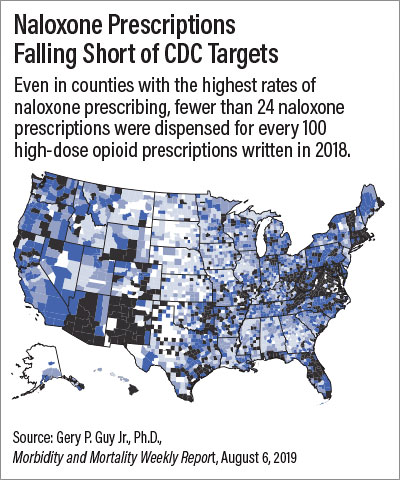Naloxone Dispensing Is Increasing, But Remains Low Overall
Abstract
A CDC study finds that just one prescription for the medication that reverses the effects of opioid overdoses is dispensed for every 69 high-dose opioid prescriptions. Psychiatrists lead specialty groups with the most naloxone prescriptions dispensed.
Naloxone dispensing has increased in recent years, but remains low overall, according to a study in the Morbidity and Mortality Weekly Report. A key finding of the study—that just one naloxone prescription is dispensed for every 69 high-dose opioid prescriptions nationwide—suggests that naloxone prescribing is falling far short of the recommendations outlined in the CDC “Guideline for Prescribing Opioids for Chronic Pain.” The guideline recommends that prescribers consider prescribing naloxone when a patient has risk factors for overdosing, such as taking high doses of opioids, taking benzodiazepines along with opioids, or having a history of overdose or substance use disorder.
Gery P. Guy Jr., Ph.D., a health economist in the CDC’s Division of Unintentional Injury Prevention, and colleagues analyzed data on naloxone dispensing from a national database of more than 50,000 pharmacies. They examined changes in naloxone dispensing from 2012 to 2018 nationwide, by U.S. census region, and by county status such as metropolitan or rural.

Naloxone dispensing increased nationwide from 1,282 prescriptions in 2012 to 556,847 prescriptions in 2018, with prescriptions more than doubling from 2017 to 2018 alone. Among all prescriber specialty groups, psychiatrists had the highest rate of naloxone prescriptions dispensed in 2018, approximately 13 for every 100 high-dose opioid prescriptions, followed by addiction medicine specialists and pediatricians. However, even in counties with the highest rates of naloxone prescribing, fewer than 24 naloxone prescriptions were dispensed for every 100 high-dose opioid prescriptions.
“The substantial increase in naloxone being dispensed from retail pharmacies is remarkable and encouraging, but despite this increase, there is still a long way to go to ensure that patients who could benefit from naloxone receive it,” Guy told Psychiatric News. “If every patient with a high-dose opioid prescription received a naloxone prescription, nearly 9 million more naloxone prescriptions would have been dispensed in 2018.”
Yet naloxone prescribing may be only part of the picture, Guy said, noting that patients may not be filling their prescriptions.
“Cost likely plays an important role. Our analysis found that 58% of naloxone prescriptions required a patient copayment, with 71% of Medicare prescriptions requiring a copay,” Guy said. “Reducing insurance copayments could be an effective way to increase access to naloxone among patients.”
Naloxone dispensing was 25 times greater in the highest dispensing counties than the lowest dispensing counties, with the highest county-level dispensing rates occurring in states hit hard by opioid overdose deaths, such as Florida, Massachusetts, and Tennessee. Additionally, states that have implemented requirements for naloxone co-prescribing, such as Arizona and Virginia, had high rates of naloxone dispensing.
“There are many opportunities in local communities across the U.S. to strengthen efforts to get naloxone into the hands of people who are at risk for experiencing or responding to an opioid overdose,” said Guy. “The substantial variation across counties demonstrates the need for better standardization of naloxone prescribing practices.”
Guy emphasized the importance of naloxone in a multipronged approach to addressing the opioid crisis.
“Comprehensively addressing the opioid overdose epidemic will require efforts to improve naloxone access and distribution in tandem with efforts to prevent initiation of opioid misuse, improve opioid prescribing, implement harm-reduction strategies, promote linkage to medications for opioid use disorder treatment, and enhance public health and public safety partnerships,” Guy said.
Data were provided by IQVIA, a private contract research company. ■
“Pharmacy-Based Naloxone Dispensing—United States, 2012-2018” is posted here.



